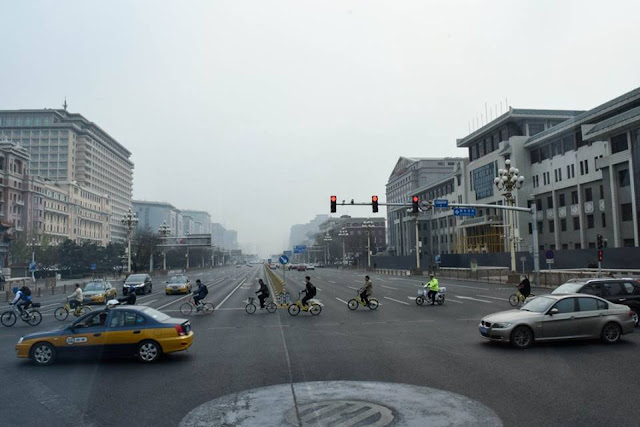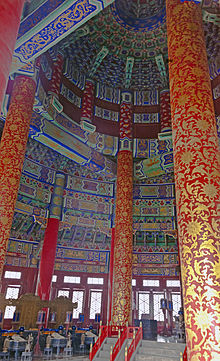Thiên Đền- Temple du Ciel -Temple of Heaven China
Năm 1998, Thiên Đàn được UNESCO công nhận là di sản thế giới.
Việc xây dựng quần thể Thiên Đàn bắt đầu năm 1420, và sau đó là nơi mà các hoàng đế nhà Minh và nhà Thanh thực hiện các nghi lễ tế trời - nghi lễ quan trọng nhất trong năm.
Bắt đầu được thăm viếng Thiên đền
Điện Kỳ Niên
nhiều cổng vào
điểm tụ họp với tour guide

hoa Xuân nở rộ hai bên đường rất đẹp mắt

**************************************
Thiên Đàn (đền)
Bách khoa toàn thư mở Wikipedia
Đối với các định nghĩa khác, xem Thiên Đàn.
| Thiên Đàn | |
|---|---|
| Quốc gia | |
| Kiểu | Văn hóa |
| Hạng mục | i, ii, iii |
| Tham khảo | 881 |
| Vùng UNESCO | Châu Á-Thái Bình Dương |
| Lịch sử công nhận | |
| Công nhận | 1998 (kì thứ 22) |
Thiên Đàn hay Đàn thờ Trời (giản thể: 天坛; phồn thể: 天壇; bính âm: Tiāntán; tiếng Mãn Châu: Abkai mukdehun) là một quần thể các tòa nhà ở nội thành Đông Nam Bắc Kinh, tại quận Tuyên Vũ. Việc xây dựng quần thể Thiên Đàn bắt đầu năm 1420, và sau đó là nơi mà các hoàng đế nhà Minh và nhà Thanh thực hiện các nghi lễ tế trời - nghi lễ quan trọng nhất trong năm. Quần thể được xây trên diện tích 2,73 km² của khuôn viên, bao gồm 3 tổ hợp công trình, bố cục chặt chẽ theo các đòi hỏi của triết học:
- Viên Khâu Đàm (圜丘坛 - gò đất), bệ thờ chính. Đây là đài rỗng hình tròn, gồm ba tầng bằng đá hoa cương có lan can, nơi hoàng đế làm lễ tế trời;
- Hoàng Khung Vũ (皇穹宇 -), là một điện nhỏ một tầng hình tròn, nằm ở phía Bắc Viên Khâu, là nơi đặt các bài vị tế trời vào những ngày không phải dịp tế lễ. Xung quanh Hoàng Cung Vũ có một bức tường cao 6 m quây thành hình tròn có đường kính 32.5 m, đây là bức tường hồi âm nổi tiếng mà đứng một đầu tường có thể nghe rõ tiếng nói ở đầu tường bên kia.
- Điện Kỳ Niên (祈年殿), tòa điện lớn hình tròn có ba tầng mái, được xây trên ba tầng của đài đá hoa cương, là nơi hoàng đế đến cầu vào mùa hè cho mùa màng tươi tốt.
Thời Trung Hoa cổ đại, các hoàng đế Trung Hoa được xem như Thiên Tử - con Trời, người thay mặt Trời cai trị thiên hạ. Việc cúng tế Trời được coi là cực kỳ quan trọng. Khu đền này được xây dựng để dành cho các nghi lễ này, trong đó các lời cầu khấn chủ yếu là để cho thiên hạ thái bình, mưa thuận gió hòa.
Ngày Đông chí hàng năm, hoàng đế và toàn bộ đoàn tùy tùng đi qua thành phố để đến đóng trại bên trong khu Thiên Đàn, mặc những bộ trang phục đặc biệt và ăn chay; tại đó hoàng đế sẽ đích thân cử hành lễ tế Trời cho mùa màng bội thu. Nghi lễ phải được hoàn tất một cách hoàn hảo; người ta tin rằng chỉ một sơ suất nhỏ nhất cũng có thể là một điềm xấu cho toàn bộ quốc gia trong năm tới.
Thiên Đàn là đàn lớn nhất trong 4 đàn ở Bắc Kinh. Các đàn còn lại là: Nhật Đàn (日坛) ở phía đông, Địa Đàn (地坛) ở phía bắc, và Nguyệt Đàn (月坛) ở phía tây.
Theo Tân Hoa Xã, vào đầu năm 2005, Thiên Đàn được trải một cuộc trang hoàng bề mặt với chi phí 47 triệu Nhân dân tệ (5,9 triệu đô la Mỹ) để chuẩn bị cho Thế vận hội Bắc Kinh mùa hè năm 2008. Việc sửa sang này hoàn tất ngày 1/5/2006.
Tham khảo[sửa | sửa mã nguồn]
Liên kết ngoài[sửa | sửa mã nguồn]
Temple of Heaven
From Wikipedia, the free encyclopedia
"Tian Tan" redirects here. For the Big Buddha statue in Hong Kong, see Tian Tan Buddha.
| This article includes a list of references, but its sources remain unclear because it has insufficient inline citations. (October 2016) (Learn how and when to remove this template message) |
| Temple of Heaven | |
|---|---|

Hall of Prayer for Good Harvests, the largest building in the Temple of Heaven
| |
| Location | Beijing, China |
| Coordinates | 39°52′56.07″N 116°24′23.29″ECoordinates: 39°52′56.07″N 116°24′23.29″E |
| Official name: Temple of Heaven: an Imperial Sacrificial Altar in Beijing | |
| Type | Cultural |
| Criteria | i, ii, iii |
| Designated | 1998 (22nd session) |
| Reference no. | 881 |
| Region | Asia-Pacific |
| Temple of Heaven | |||

"Temple of Heaven" in Simplified (top) and Traditional (bottom) Chinese characters
| |||
| Traditional Chinese | 天壇 | ||
|---|---|---|---|
| Simplified Chinese | 天坛 | ||
| Literal meaning | "Altar of Heaven" | ||
| |||
The Temple of Heaven (Chinese: 天壇; pinyin: Tiāntán; Manchu: Abkai mukdehun) is an imperial complex of religious buildings situated in the southeastern part of central Beijing. The complex was visited by the Emperors of the Ming and Qing dynasties for annual ceremonies of prayer to Heaven for good harvest. It has been regarded as a Taoist temple,[1] although Chinese heaven worship, especially by the reigning monarch of the day, predates Taoism.
Contents
[hide]History[edit]
The temple complex was constructed from 1406 to 1420 during the reign of the Yongle Emperor, who was also responsible for the construction of the Forbidden City in Beijing. The complex was extended and renamed Temple of Heaven during the reign of the Jiajing Emperor in the 16th century. Jiajing also built three other prominent temples in Beijing, the Temple of Sun (日壇) in the east, the Temple of Earth (地壇) in the north, and the Temple of Moon (月壇) in the west. The Temple of Heaven was renovated in the 18th century under the Qianlong Emperor. By then, the state budget was insufficient, so this was the last large-scale renovation of the temple complex in imperial times.
The temple was occupied by the Anglo-French Alliance during the Second Opium War. In 1900, during the Boxer Rebellion, the Eight Nation Alliance occupied the temple complex and turned it into the force's temporary command in Beijing, which lasted for one year. The occupation desecrated the temple and resulted in serious damage to the building complex and the garden. Robberies of temple artifacts by the Alliance were also reported.[citation needed]With the downfall of the Qing, the temple complex was left un-managed. The neglect of the temple complex led to the collapse of several halls in the following years.[2]
In 1914, Yuan Shikai, then President of the Republic of China, performed a Ming prayer ceremony at the temple, as part of an effort to have himself declared Emperor of China. In 1918 the temple was turned into a park and for the first time open to the public.
The Temple of Heaven was inscribed as a UNESCO World Heritage Site in 1998 and was described as "a masterpiece of architecture and landscape design which simply and graphically illustrates a cosmogony of great importance for the evolution of one of the world’s great civilizations..." as the "symbolic layout and design of the Temple of Heaven had a profound influence on architecture and planning in the Far East over many centuries."[2]
Buildings and layout[edit]
The Temple grounds cover 2.73 km² of parkland and comprises three main groups of constructions, all built according to strict philosophical requirements:
- The Hall of Prayer for Good Harvests (祈年殿) is a magnificent triple-gabled circular building, 36 meters in diameter and 38 meters tall, built on three levels of marble stone base, where the Emperor prayed for good harvests. The building is completely wooden, with no nails. The original building was burned down by a fire caused by lightning in 1889.[3] The current building was re-built several years after the incident.
- The Imperial Vault of Heaven (皇穹宇) is a single-gabled circular building, built on a single level of marble stone base. It is located south of the Hall of Prayer for Good Harvests and resembles it, but is smaller. It is surrounded by a smooth circular wall, the Echo Wall, that can transmit sounds over large distances. The Imperial Vault is connected to the Hall of Prayer by the Vermilion Steps Bridge, a 360-metre-long (1,180 ft) raised walkway that slowly ascends from the Vault to the Hall of Prayer.
- The Circular Mound Altar (圜丘坛) is the altar proper, located south of the Imperial Vault of Heaven. It is an empty circular platform on three levels of marble stones, each decorated by lavishly carved dragons. The numbers of various elements of the Altar, including its balusters and steps, are either the sacred number nine or its nonuples. The center of the altar is a round slate called the Heart of Heaven (天心石) or the Supreme Yang (太阳石), where the Emperor prayed for favorable weather. Thanks to the design of the altar, the sound of the prayer will be reflected by the guardrail, creating significant resonance, which was supposed to help the prayer communicate with Heaven. The Altar was built in 1530 by the Jiajing Emperor and rebuilt in 1740.[3]
Ceremony[edit]
In ancient China, the Emperor of China was regarded as the Son of Heaven, who administered earthly matters on behalf of, and representing, heavenly authority. To be seen to be showing respect to the source of his authority, in the form of sacrifices to heaven, was extremely important. The temple was built for these ceremonies, mostly comprising prayers for good harvests.
Twice a year the Emperor and all his retinue would move from the Forbidden City through Beijing to encamp within the complex, wearing special robes and abstaining from eating meat. No ordinary Chinese was allowed to view this procession or the following ceremony. In the temple complex the Emperor would personally pray to Heaven for good harvests. The highpoint of the ceremony at the winter solstice was performed by the Emperor on the Earthly Mount. The ceremony had to be perfectly completed; it was widely held that the smallest of mistakes would constitute a bad omen for the whole nation in the coming year.
Symbolism[edit]
Earth was represented by a square and Heaven by a circle; several features of the temple complex symbolize the connection of Heaven and Earth, of circle and square. The whole temple complex is surrounded by two cordons of walls; the outer wall has a taller, semi-circular northern end, representing Heaven, and a shorter, rectangular southern end, representing the Earth. Both the Hall of Prayer for Good Harvests and the Circular Mound Altar are round, each standing on a square yard, again representing Heaven and Earth.
The number nine represents the Emperor and is evident in the design of the Circular Mound Altar: a single round marmor plate is surrounded by a ring of nine plates, then a ring of 18 plates, and so on for a total of nine surrounding rings, the outermost having 9×9 plates.
The Hall of Prayer for Good Harvests has four inner, twelve middle and twelve outer pillars, representing the four seasons, twelve months and twelve traditional Chinese hours respectively. Combined together, the twelve middle and twelve outer pillars represent the traditional solar terms.
All the buildings within the Temple have special dark blue roof tiles, representing the Heaven.
The Seven-Star Stone Group, east of the Hall of Prayer for Good Harvest, represents the seven peaks of Taishan Mountain, a place of Heaven worship in classical China.
There are four main supportive, dragon pillars each representing a season. The structure, held up by these dragons, imitates the style of an ancient Chinese royal palace. Twelve inner pillars symbolize the lunar months, and it is thought that the twelve outer pillars refer to the 12 two-hour periods of the day.
Park[edit]
The surrounding park is quite extensive, with the entire complex totaling 267 hectares (660 acres). Some of it consists of playgrounds, exercise and game areas. These facilities are well used by adults, as well as by parents and grandparents bringing children to play. Some of the open spaces and side buildings are often used, particularly in the morning, for choral shows, ethnic dances, and other presentations.
Access[edit]
The Temple of Heaven is located in southern Dongcheng District, which until 2010 was part of Chongwen District. The park itself is open daily from 6:00-22:00pm. The relic sites inside the park open at 8:00 and close at 17:30 from March 1 to June 30, 18:00 from July 1 to October 31, and 17:00 from November 1 to February 28.[4] There is a nominal entry charge.
All four of the park's gates are accessible by public transportation.
- East Gate on Tiantan East Rd. and Tiyuguan Rd.: Beijing Subway Line 5 Tiantandongmen Station; Beijing Bus routes 25, 36, 39, 208, 525, 610, 685, 686, 723, 827, 829, 957, 958
- West Gate on Tianqiao South St. and Nanwei Rd.: Beijing Bus route 2, 15, 17, 20, 35, 36, 69, 71, 120, 203, 504, 707, 729, BRT1, 特11
- North Gate on Tiantan Rd. and Qinnian St.: Beijing Bus routes 6, 34, 35, 36, 106, 110, 687, 707
- South Gate on Yongdingmen East St. and Jintai Rd.: Beijing Bus routes 36, 53, 120, 122, 208, 525, 610, 958, 特3, 特11, 特12, 运通102
See also[edit]
- Tian (Heaven) / Shangdi (God)
- Heaven worship
- All Under Heaven
- Son of Heaven
- Wongudan (Seoul, Korea)
References[edit]
Citations[edit]
- ^ Cooper, Jean C. Cooper and William Stoddart (2010). An Illustrated Introduction to Taoism: The Wisdom of the Sages. World Wisdom. p. 24. ISBN 9781935493167.
- ^ "Temple of Heaven: an Imperial Sacrificial Altar in Beijing - UNESCO World Heritage Centre". Whc.unesco.org. 1998-12-02. Retrieved 2016-10-31.
- ^ a b "Temple of Heaven Park in Běijīng, China". Lonely Planet. Retrieved 2016-10-31.
- ^ "Tiantan Park". En.tiantanpark.com. Retrieved 2016-10-31.
Sources[edit]
- Temple of Heaven
- Temple of Heaven, CCTV documentary



















































































































